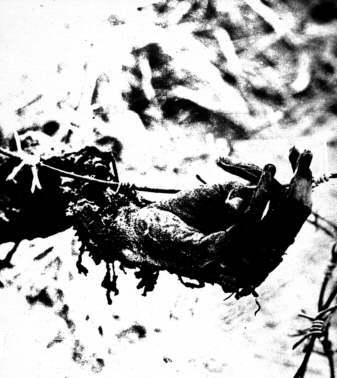
|
The ‘hidden hand’ – one that doesn’t venture onto the battlefield – promotes war so that, to double advantage, white men kill each other while ethnic warfare is waged from the rear. This occurred in both WWI and WWII |
When Jim Crow Met John BullGraham A. Smith |
|
The Great War |
The overriding dread
The most controversial order on segregation issued in France during the Great War (and in many ways closely resembling some official instructions in Britain in the 1940s) was a document of 7 August 1918, issued by the Chief of the French Mission at the headquarters of the American Expeditionary Force, Colonel J. A. Linard. Though intended for French officers and written by a Frenchman, there can be little doubt that the document was issued with US support and possibly with Pershing’s authority. Entitled ‘Confidential: Au sujet des Troopes Noires Americaines,’ the document’s purpose was to instruct the French in the white American attitude to the ‘colour question.’ There was concern at the ‘familiarity and indulgence’ with which the French were treating the black soldier. The black man, it continued, was ‘an inferior being’ and his ‘vices’ were a ‘constant menace.’ Hence, Linard announced: ‘We must prevent the rise of any pronounced degree of intimacy between French officers and black officers.... We must not eat with them, must not shake hands or seek to talk or meet with them outside of the requirements of military service.... Make a point of keeping the native cantonment population from “spoiling” the Negroes.’
The fears of the white American officials were transparent enough. One of these was of equal concern back in the USA – the overriding dread of sex relations between black men and white women; such relations, it was hoped, could be avoided through rigid segregation. Hence the US Army saw fit to issue instructions on this matter. From the Le Mans area in Mienne on 26 December 1918 came an order from Brigadier General Erwin that one of the duties of the military was to ‘prevent enlisted men from addressing or holding conversations with the women inhabitants of the town.’ A few months later an order issued to the black 804th Pioneer Infantry on 20 March 1918 was even more blunt. These enlisted men were not to talk ‘or be in company’ with white women regardless of what these women might feel. The basis of this fear was the belief that whatever freedom the black soldier enjoyed while serving overseas in the Great War would lead to demands for the same kind of treatment on his return to the USA. Major General Charles C. Ballou thought that social equality, which was the ‘dominant idea with many,’ would cause many blacks to be very much set up by this new and agreeable condition.’
Despite the vehemence of American instructions, and their regularity, the French populace ignored the white American view and afforded the black soldier an equality he had not known before. (pp. 10-11)
Women of culture and refinement
Furthermore, despite all the prohibitions, it was reported that there were about 1,000 – 2,000 marriages between black Americans and French women, including, according to Colson, ‘a surprisingly fair percentage... among women of culture and refinement,’ and this in itself fostered some of the white fears. (p. 12)
Ghastly outbreaks
The most important of the concerns were whether black women should be sent to comfort black men, as well as the incidence of rape and venereal disease amongst the black troops. Involved with these problems were the apocryphal stories of black sexuality that British newspapers, too, were not immune from publishing. The London Daily Herald, a left-wing paper, said about the Great War that ‘whenever there are black troops who have been long distant from their own womenfolk there follows a ghastly outbreak of prostitution, rape and syphilis.’ (p. 12)
Red rag to a bull
‘The fact is simply that the Negro walking with a white woman is to the southern American White as a red rag to a bull.’ (p. 13)
Blacks in combat
Henry Stimson revealed that [General George C.] Marshall could be quite derogatory about black troops, noting in his diary his agreement with the Chief of Staff’s assessment of the performance of the 92nd Division in the First World War: ‘As Marshall remarked, the only place they could be counted on to stand would be in Iceland in summertime where there was daylight for twenty-four hours.’ (p. 26)
Graham A. Smith, When Jim Crow Met John Bull: Black American Soldiers in World War II Britain. Tauris, London, 1987.